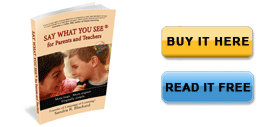Seeing Kids With “New Eyes”

A first-grader gets overwrought at a school party and starts to have a melt-down. Instead of telling her to settle down, the teacher says, “Seems like you’ve had enough. If you’d like, you can hide under the table with me for a little while.” According to the parent who shared this with me, it only took a couple of minutes of hiding before the child was ready to rejoin the class.
Don’t you just love that? That’s Language of Listening® in action. SAYing WHAT YOU SEE helps you see kids’ needs instead of reacting to their behavior. It’s like seeing with “new eyes” that make it easy to respond with love and understanding instead of force.
Here’s another example I heard where “new eyes” could’ve made a big difference for a mom and daughter out shopping:
Old Eyes – A mother plans a special fun shopping trip with her teen. The shopping goes well until the teen gets a call from a friend and wants to go see her friend instead. Mom feels slighted and stands her ground about finishing their shopping trip, but now she has to put up with her teen’s whining as she drags her from store to store.
New Eyes – When the teen asks if she can go meet her friend, Mom could say, “You are so excited to see your friend. You always have such fun together. Must be some way you can do that. Let me see. It’s hard for me to set aside time for us to shop together, and we are here now. Hmmm. If we hurry we can get everything done, and I’ll be able to drop you off in an hour.”
Can you feel the difference? With Mom on her side, she could help get the shopping done in record time and keep it fun for them both. The more you SAY WHAT YOU SEE®, the more examples you see of struggles that could easily be avoided. What examples have you seen lately that either were avoided with a little love and understanding or could have been?
2 Comments






This scenario reminds me of the time my teen daughter and I had planned to watch a movie together on TV. Then friends of hers invited her to do something. I felt both disappointment for my loss and excited for her to have an evening with friends. I verbalized all of this to her and she responded by giving me a hug before she went out. In that moment of her showing me compassion and tending to her needs anyway, I felt proud of both of us. For me, SWYS is also about saying what someone cannot see, which is what is going on in me!
Chris, you recognized that SWYS includes saying the unsaid. Thanks for bringing out that point!
And sharing that you had two feelings at once is a great way to help kids expand their emotional awareness.
But I’d say the biggest thing you modeled for your daughter was ownership of your own feelings. Your disappointment was clearly yours, not hers to manage for you. Owning your feelings allowed her to own hers and make the choice that was the perfect challenge for her growth – friends.
That kind of emotional safety and freedom to “be” creates a deep feeling of connection which is often expressed with a hug. Thank you so much for sharing your example! – Sandy